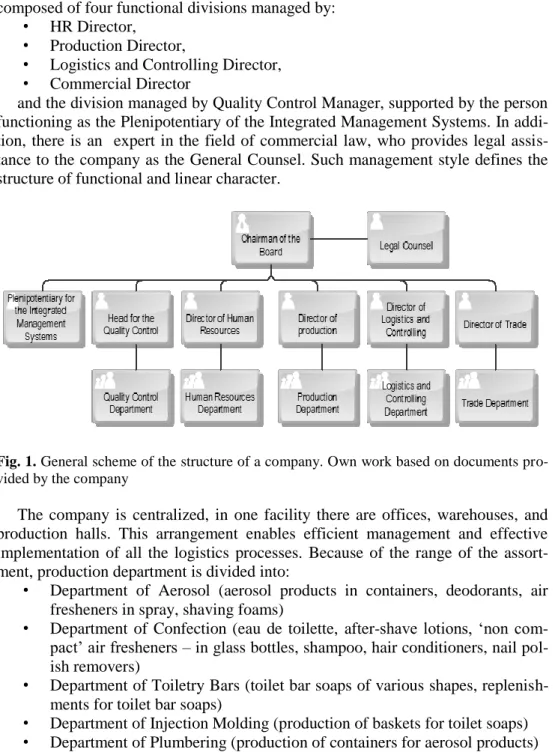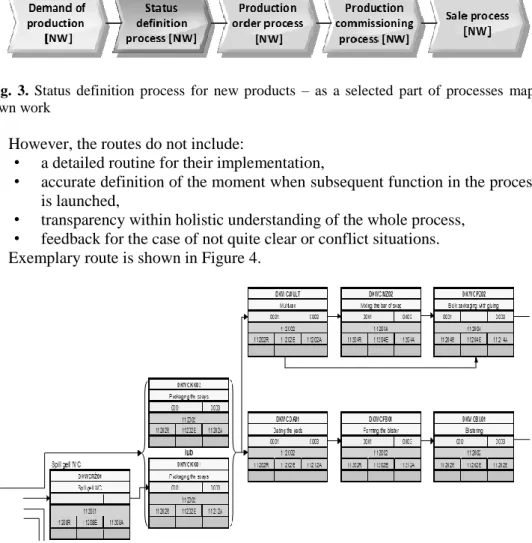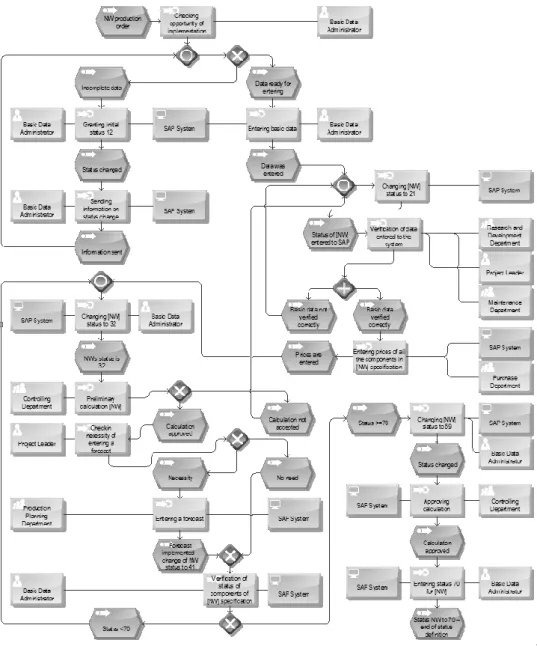THE MODEL OF STATUS DEFINITION PROCESS
IN THE BASIC DATA MANAGEMENT SYSTEM
– A CASE STUDY
Aleksander Jurga* and Dominik Czerkawski**
* Chair of Management and Computing Systems, Poznan University of Technology, Poznan, 60-965, Poland, Email: aleksander.jurga@put.poznan.pl
** Dramers S.A., Olszynowa 38, 62-020 Swarzędz, Poland
Abstract: Logistics processes in manufacturing companies are focused on issues related to sales and
distribution, as well as with production planning, materials management and supply. The process of production planning is one of the most important in the entire logistics chain. Launching a new product is preceded by a number of sub-processes. In the case of the company presented in the article, the process to start with is the status definition process. The paper presents a model of the status definition process for a new product in basic data management system -SAP. To design the status definition process presented in the paper a dedicated IT tool (ARIS Platform) was implemented.
Paper type: Case Study
Published online: 10 July 2017
Vol. 7, No. 3, pp. 259–268
DOI: 10.21008/j.2083-4950.2017.7.3.7 ISSN 2083-4942 (Print)
ISSN 2083-4950 (Online)
© 2017 Poznan University of Technology. All rights reserved.
1. INTRODUCTION
Logistics processes in manufacturing companies are focused on issues related to sales and distribution, planning production, management of materials and supplies. In more general terms they also include such areas of companies’ functioning as: planning, implementing and controlling of economically efficient and effective flow of raw materials, semi-finished and finished products. Additionally, they refer to logistics functions such as customer service, order processing, packaging, waste management and transport (Jurga & Sławińska, 2011, p. 21). Moreover, they may also include organizational structures not directly related to the core business of the company.
In the entire logistics chain one of the most important is the process of produc-tion planning. Especially when it concerns the producproduc-tion of a new product. Pro-duction of a new product is preceded by a number of processes / sub-processes. In the case of the company presented in the article, status definition is the first process. The article presents a model of the business process of status of a new product definition in the basic data management system-SAP. The process to be modeled was selected from the map of business processes. It is essential for full implementation of a new product manufacturing. To design the status definition process a dedicated IT tool (ARIS Platform) was implemented. It is worth empha-sizing that the tool allows for comprehensive modeling of all aspects of a business organization, including modeling the organization, facilities-oriented trees of func-tions, activities and processes, as well as developing diagrams of objectives and functions, defining measures for achieving the objectives, and modeling of busi-ness processes and information systems to support them (Jurga, 2013, p. 213).
2. BUSINESS PROCESS DESIGN AND MODELLING
2.1. The goal of processes modeling
Business process modeling is related to business process design. It is used to de-termine how the organization operates, and it can be useful to dede-termine the proc-esses to be excuted in the structure of the company. While model (also called Module – measure or pattern) is a simplified reflection of reality, i.e. the system mapping processes analogous to those in the enterprise (Adamczyk & Jurga et al., 2010, p. 95).
The main goals of models application are the following (Mendel, 2004, p. 48): • subjective evaluation of the present state/condition,
• disclosure of errors in processes execution, • definition directions of expected changes,
• appropriate intensification of predefined factors,
• determination of the optimal program of reorganization of the company's organizational structure.
Modeling should always be preceded by analysis of the company's organiza-tional structure. The next step is to identify the processes. In business process mo-deling, model is the base to determine the start and end points of the main proc-esses. They may then be decomposed into individual sub-procproc-esses. This procedure enables understanding the flow of work in the organization. Hence, the process is the highest unit of work in the company. Its components are sub-processes, which can be decomposed into operations and activities (Bitkowska, 2009, p. 63).
2.2. Stages of process design
The basic stage of processes design is their mapping. This operation allows to illustrate where and how a business organization creates value for a customer. The basic mapping features include the ability to determine the boundaries of systems and subsystems of a company and the links between processes.
Description of the process requires answearing the questions listed below: • Who owns the process?
• Who will be responsible for the project and its implementation? • Who will be responsible for the maintenance of processes description? • What resources are required?
• What are the criteria for determining whether the goal was achieved (measures of success)?
Process mapping is a starting point for developing a map of processes – and their classification. It extracts the processes and some of the sub-processes (more important ones). It shows flows of information or material between processes. The starting point for modeling is developing a model of the actual implementation of processes, and basing, among others, on it suggesting improvements to the process (Jurga, 2013, p. 209). It is worth noting that although the process model is closely related to the flow chart, it above all enables understanding of functioning of the process.
3
. CASE STUDY
3.1. Presentation of the company
The organization as a Joint Stock Company is a large manufacturer in the FMCG sector with 100% of Polish capital. It is a manufacturer and distributor of cosmetics and household chemistry. It operates in the Wielkopolska region. It
em-ploys a total of approx. 350 employees. The company is managed by the CEO, and composed of four functional divisions managed by:
• HR Director, • Production Director,
• Logistics and Controlling Director, • Commercial Director
and the division managed by Quality Control Manager, supported by the person functioning as the Plenipotentiary of the Integrated Management Systems. In addi-tion, there is an expert in the field of commercial law, who provides legal assis-tance to the company as the General Counsel. Such management style defines the structure of functional and linear character.
Fig. 1. General scheme of the structure of a company. Own work based on documents
pro-vided by the company
The company is centralized, in one facility there are offices, warehouses, and production halls. This arrangement enables efficient management and effective implementation of all the logistics processes. Because of the range of the assort-ment, production department is divided into:
• Department of Aerosol (aerosol products in containers, deodorants, air fresheners in spray, shaving foams)
• Department of Confection (eau de toilette, after-shave lotions, ‘non com-pact’ air fresheners – in glass bottles, shampoo, hair conditioners, nail pol-ish removers)
• Department of Toiletry Bars (toilet bar soaps of various shapes, replenish-ments for toilet bar soaps)
• Department of Injection Molding (production of baskets for toilet soaps) • Department of Plumbering (production of containers for aerosol products) • Department of Control for aerosols, confection, toilet bars (production of
The company produces more than 3.5 million pieces of products per month and exports them to over 50 countries worldwide. It also manufactures products for its customers, signed with their brand (logo).
3.2. The process modeled
In the presented company, these process of status definition for the new product [NW] is a key process of the enterprise. It is realized within the Department of Logistics and Controlling supervised by its Director. Organizational unit responsi-ble for the execution of the process is the Basic Data Administrator, in cooperation with the departments of:
• Research and Development, • Purchasing,
• Production Planning, • Controlling.
Fig. 2. Organizational structure of the Logistics and Controlling Department. Own work
based on the documents provided by the company.
It is associated with other processes performed in the company and in particular is entered in the chain of production processes. Its location it is shown in Figure 3.
Previously, the status definition process was implemented on the basis of technological routes. They were developed by the company to codify rules for exe-cution of the whole production process. They covered all the processes/sub-processes of production and defined the important steps within these processes/sub-processes. Each route has a unique number in the SAP system and the name. It is always
defined for a particular new product, especially when it is newly produced in the company on a dedicated production line or for a group of new products (some NWs may be produced with the same technology). Routes include, inter alia, specifica-tion of workstaspecifica-tions and the order of important steps of producspecifica-tion of a new prod-uct. Each workstation in the route has a unique number, name, specified per shift performance (optionally: assigned human and/or technical resource, energy consumption per unit per shift, depreciation and amortization).
Fig. 3. Status definition process for new products – as a selected part of processes map.
Own work
However, the routes do not include:
• a detailed routine for their implementation,
• accurate definition of the moment when subsequent function in the process is launched,
• transparency within holistic understanding of the whole process, • feedback for the case of not quite clear or conflict situations. Exemplary route is shown in Figure 4.
Fig. 4. The part of a route presenting semi-formal description of the production process
Such approach was not conducive for efficiency of performance within the status definition process. It was executed based on intuition and exploited routes implemented in the company and job assignment schemes. However, this resulted in many situations Basic Data Administrator [ADP] had to deal with, basic on his knowledge and professional experience. However, in the absence of an accurate model of the status definition process, often he needed to:
• call or personally contact departments collaborating with ADP,
• make decisions that were not always accurate (after completion of the NW status definition process and launching production it turned out that the production lacks a specific component, which has been assigned in the status definition process, so they have to look for a replacement).
This was consequence of the lack of automation of sending notification of granting appropriate status to NW (which was done by Basic Data Administrator) to persons and departments working with him.
For this reason, the authors attempted to model the status definition process according to the paradigms of business process modeling and design.
3.3. Status definition process modeling
The tool implemented to model the analyzed process was the ARIS Platform. The model was developed with EPC notation . Selection of the notation methodol-ogy was not accidental, as it is the solution implemented in the ARIS Platform. Moreover, the EPC notation was developed in cooperation with SAP developers and has been used for over 25 years all over the world. It enables construction of process flow diagrams that are comprehensible for process designers, analytics and managers at various levels of hierarchy.
The starting point for modeling the process was, among others: • the exact analysis of technological routes,
• identification of the actual course of the process (step by step), • allocation on the processes map,
• identification of contractors involved in process implementation and their responsibility for the process.
Then, the model has been designed on paper, and subjected to an in-depth analysis whether it is affected by semantic errors, compatible with the syntax of business models design according to EPC notation, and if there are any important features influencing its correct realization and not considered. After positive verifi-cation of the model developed (an important task for Basic Data Administrator) the reference model was designed (Jurga & Dziembek, 2015, pp. 73–84). The tar-get model was developed on the basis of the before-mentioned. It is presented in the Figure 5.
Fig. 5. Model of status of new product definition for the process. Own work
The starting point (launching) of the process is the order for production of a new product. Its status definition process starts with activating the Feasibility check function. This function is performed by Basic Data Administrator who receives the electronic document with the data necessary to introduce NW to SAP. When in-formation in the document obtained is incomplete, ADP performs the function Granting of the initial status 12. Information concerning the status change is sent
out to those interested with the Send information on the change in status function. At this stage it is not possible to continue the NW status definition process. It is necessary to return to the Feasibility check function. When information in the document is complete, ADP introduces basic data to the SAP system. The result is a change of NW status to 21. Then, the data implemented to the system when defining he status of a new product is verified. The verification is conducted by persons performing functional tasks of the Research and Development Department, Department of Maintenance and Project Leader.
In the case of incorrect verification, after completing or correcting the basic data introduced to the system, Change the NW status to 21 function is activated again. This feedback loop is executed until the basic data is properly verified. And this in turn results in calling the Definition of prices for all the components in the NW specification function to be performed by an employee of the Purchasing Depart-ment, whose task is to introduce the prices into the SAP system. After performing this function, Basic Data Administrator changes the NW status to 32. It results in performing the further steps, namely the Preliminary calculation for NW function. It is performed by an employee of Controlling Department, who carries out the calculation of a new product cost. The result of completing the function is generat-ing events that define the decision concerngenerat-ing acceptance of the calculation made, or lack thereof. In the case of non-acceptance process is withdrawn and directed to perform Change the status NW to 21 function. Positive verification directs the process towards performing the function Checking the necessity of forecasts. Sales forecast for NW is developed by Project Leader, thus deciding whether it is required for the implemented product or not. When required, the forecast is intro-duced to the SAP system by the employee of the Department of Production Plan-ning. This proves the NW transition to the next status and the ability to activate the next function of the process. The target step in the process of status definition for a new product is to bring it to the final status of 70. This is enabled by the function Introduction of the status of 70 for NW, which ends with the last step of the proc-ess: Status NW to 70 – the end of status definition. To reach this stage, the Admin-istrator of the Basic Data has to carry out verification of specifications of compo-nents of a new product and a Controlling Department employee has to approve the calculation of NW in the SAP system.
Importance of the Maintenance department employee can be noticed in the model. In the overall scheme of the structure of the company, this employee is delegated to participate in the process by the Maintenance Manager, assigned to the division managed by the Manufacturing Manager (Fig. 1). The job of the Mainte-nance employee within the status of NW definition process is verification of the data entered in the SAP system in terms of technical preparation of production, i.e. in particular checking or correcting routing assigned to a new product. Accord-ing to the process modelled, the Project Leader is also directly involved in the status of NW definition process. The Leader participates in Verification of the data entered into the system and Checking the necessity of the forecast introduction.
Leader’s function is reduced to the role of supervisor of the whole status definition process. The Responsibility Assignment Matrix was developed for the process, as well as the process chart, and the owner of the process was identified (Basic Data Administrator) as well as the procedure for process implementation.
4. CONCLUSION
Logistics processes are carried out always and in every company, regardless of size, industry or market area in which the company operates. Their reengineering is extremely difficult due to the fact that they are crucial for effective functioning of manufacturing enterprises. This is also the case of the company described in the article. In this case, the additional difficulty for reengineering process of status definition procedure was the fact that so far it was carried out on the basis of the predefined routing. However, the routes do not take into account many important factors that could affect its execution. Among other things, that was the reason for which the authors applied business process design canons for modeling the proce-dure, as the diagram of the process enables its understanding by all the execu-tors/operators. And although the presented approach was applied in the company for the first time, the process has a very good chance for implementation.
REFERENCES
Adamczak M., Jurga A., Kałkowska J., Pawłowski E. & Włodarkiewicz-Klimek H. (2010), Projektowanie systemów informacyjnych zarządzania, Wyd. Politechniki Poznań-skiej, Poznań.
Bitkowska A. (2009), Zarządzanie procesami biznesowymi w przedsiębiorstwie, VIZJA PRESS & IT, Warszawa.
Jurga A. & Sławińska M. (2011), Choosen Aspects of Designing Information Systems Sup-porting Logistic Processes, Solutions for SupSup-porting the Processes of Adminis-tration, Logistics and Manufacturing – Selected Aspects, K. Grzybowska, P. Pawle-wski (eds.), Publishing House of Poznan University of Technology, Poznan.
Jurga A. (2013), Wybrane aspekty modelowania procesów biznesowych, Zeszyty Naukowe nr 762. Ekonomiczne problemy usług nr 104. Europejska przestrzeń komunikacji elektronicznej. Tom 1, Wydawnictwo Naukowe Uniwersytetu Szczecińskiego, Szczecin, pp. 207-217.
Jurga A. & Dziembek D. (2015), Paradygmaty projektowania referencyjnych modeli proce-sów. Jelonek D. & Turek T., (eds.), Kreowanie przedsiębiorczości. Perspektywa procesów i technologii informacyjnych. Wyd. Wydziału Zarządzania Politechniki Częstochowskiej, Częstochowa 2015, pp. 73-84.
Keller, M. Nüttgens & A.W. Scheer (1992), Semantische Prozeßmodellierung auf der Grundlage "Ereignisgesteuerter Prozeßketten (EPK)". Veröffentlichungen des Instituts für Wirtschaftsinformatik, Heft 89.



